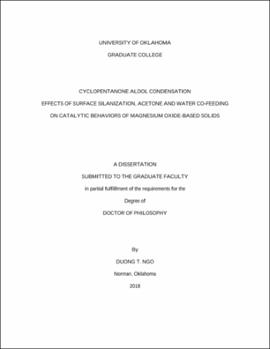| dc.contributor.advisor | Resasco, Daniel | |
| dc.contributor.author | Ngo, Duong | |
| dc.date.accessioned | 2018-12-13T20:42:40Z | |
| dc.date.available | 2018-12-13T20:42:40Z | |
| dc.date.issued | 2018 | |
| dc.identifier.uri | https://hdl.handle.net/11244/316757 | |
| dc.description.abstract | Cyclopentanone is a promising building block in the conversion of biomass to fuels. It can be readily obtained from furanics derived from biomass and can be converted to intermediate products in the molecular weight range compatible with fuels via C-C bond forming reactions. Among them, aldol condensation is a promising route. Conventional MgO catalysts are intrinsically active to catalyze this reaction, but they usually exhibit low surface areas and low stability in the presence of liquid water. The nitrate-citrate combustion method results in high-surface-area oxides with high condensation activity, but they are still susceptible to water attack. Here, hydrophobic MgO-based catalysts functionalized with octadecyltrichlorosilane (OTS) are shown to exhibit remarkable stability in the liquid phase under conditions in which a conventional MgO deactivates in short time.
A follow-up study investigates the effect of co-fed water on the MgO-catalyzed cyclopentanone self-aldol condensation. As more water is added, the initial rate on hydrophilic MgO drops rapidly due to site blockage. Meanwhile, the initial rate on hydrophobic MgO-OTS increases in water vapor before decreasing in excess liquid water. It is noteworthy that under dry conditions, kinetic studies indicate a shift in the rate-limiting step: from first-order α-H abstraction on MgO to second-order C-C coupling on MgO-OTS. A proposal is that the high OTS loading limits the interaction between cyclopentanone surface species and reduces the rate of C-C coupling. This step is, however, apparently favored by surface water clusters which bridge a liquid cyclopentanone to an Mg2+ acid site. Such assistance allows the electrophile to undergo a distant polarization which can facilitate the subsequent nucleophilic attack.
Another important biomass upgrading process is the cyclopentanone-acetone cross-aldol condensation, since the primary products – especially cyclopentanone-activated compounds – can be hydrodeoxygenated into high octane-numbered hydrocarbons. Here, the reaction is catalyzed by high-surface-area MgO. Initial rates with various feed ratios, DFT calculations and adsorption measurements confirm both the preferential chemisorption and α-H abstraction of cyclopentanone with respect to acetone. For each ketone reactant, α-H abstraction is rate-limiting, but subsequent C-C coupling equilibria along with the feed composition control the product distribution. | en_US |
| dc.language | en_US | en_US |
| dc.subject | aldol condensation | en_US |
| dc.subject | cyclopentanone | en_US |
| dc.subject | acetone | en_US |
| dc.subject | water | en_US |
| dc.subject | co-feeding | en_US |
| dc.subject | magnesium oxide | en_US |
| dc.subject | deactivation | en_US |
| dc.subject | functionalization | en_US |
| dc.subject | octadecyltrichlorosilane | en_US |
| dc.subject | nucleophilic addition | en_US |
| dc.title | CYCLOPENTANONE ALDOL CONDENSATION – EFFECTS OF SURFACE SILANIZATION, ACETONE AND WATER CO-FEEDING ON CATALYTIC BEHAVIORS OF MAGNESIUM OXIDE-BASED SOLIDS | en_US |
| dc.contributor.committeeMember | Butler, Elizabeth | |
| dc.contributor.committeeMember | Crossley, Steven | |
| dc.contributor.committeeMember | Harwell, Jeffrey | |
| dc.contributor.committeeMember | Lobban, Lance | |
| dc.date.manuscript | 2018 | |
| dc.thesis.degree | Ph.D. | en_US |
| ou.group | Gallogly College of Engineering::School of Chemical, Biological and Materials Engineering | en_US |
| shareok.orcid | 0000-0002-4368-9552 | en_US |
